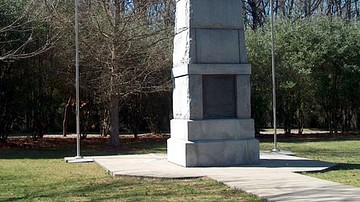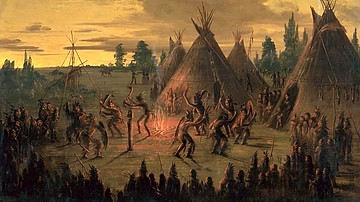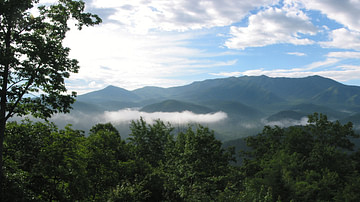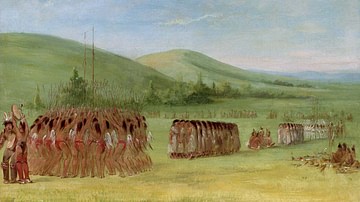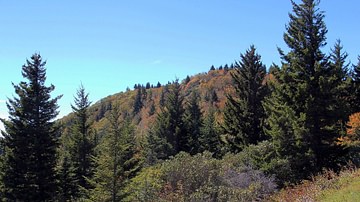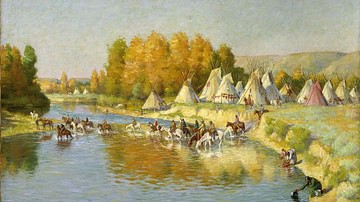The Man Who Married the Thunder Sister is a legend of the Cherokee nation about a young warrior who falls in love with a Thunder Sister and follows her home where he finds nothing is what it seems to be, not even the young woman. The story explores many themes common to Native American literature.
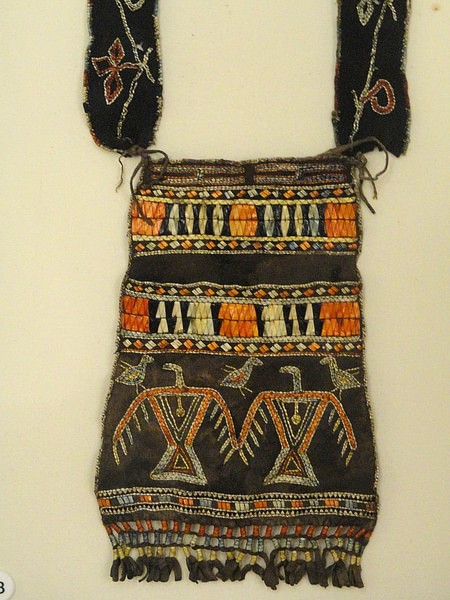
Among these is the importance of following instructions and of faith. According to Cherokee belief, the Creator God Unetlanvhi, made the tri-level world with good spirits above, bad spirits below, and humanity in the middle world, tasked with maintaining balance. Spirits from either plane could manifest themselves on earth at any given time – sometimes threatening this balance -–and so people were encouraged to proceed, in anything, through faith in Unetlanvhi to discern what kind of entity they might be encountering, whether a threat to harmony or a guide in helping one maintain celestial and terrestrial balance.
In the case of the young warrior in this story, as he follows the young woman and her sister toward their home, he is shown that his senses are deceiving him and the waters he encounters on the journey are not as they appear, but upon reaching their cave, he forgets the lessons learned, abandons his faith, and relies on his own senses. According to some interpretations of the story, he has been tested and has failed in recognizing the sisters as beneficial guides. Trusting in his own judgment, instead of proceeding by faith, he is led astray.
He later fails to heed the instructions given to him by the sisters that he should tell no one where he had gone or what he had seen there, and he suffers the consequences. This theme appears in the legends and myths of many different Native American nations and is often repeated in a cycle of stories – such as the Wihio tales of the Cheyenne or the Iktomi tales of the Lakota Sioux – in which a character repeatedly fails to follow simple instructions and must then suffer for it. The importance of following instructions appears so often in Native American tales because it is a common cultural value. Part of maintaining balance in life is recognizing and honoring tradition and the rituals that are a part of that. Deviating from how something has always been done runs the risk of throwing an individual, or community, off balance.
Another theme central to the story is the danger of blindly trusting strangers, no matter how friendly or welcoming they may appear, as they might be ghosts or evil spirits who have appeared only to lure one into trouble or strike one with sickness or even death. This theme usually runs through Native American ghost stories as ghosts, even of loved ones, were thought to sometimes appear only to draw one with them into the afterlife, and before one's appointed time. In this story, the young man instantly engages with the two beautiful sisters, even though they have never been seen in the village before, and, ignoring the traditional wisdom of approaching strangers with caution, happily follows them home.
This is not to say the Cherokee – whether in the past or present – do not welcome strangers into their community, as they certainly did and still do, but it is thought prudent to proceed with caution, trusting in one's faith to discern bright energies or dark energies in a new acquaintance. Failure to do so, as seen in the stories of many different nations, always leads to serious problems. In this story, the young warrior never pauses for a moment to question who the young women are or where they have come from and so, unwittingly, is led to the home of the Thunder Beings.
Thunder Beings & Horned Serpents
The Thunder Beings, according to some Cherokee bands (not all) are storm spirits descended from Selu, the corn goddess, through her sons, the Thunder Boys (Wild Boy and Good Boy), all featured in the Cherokee myth, The Origin of Game and Corn. The Thunder Boys are trickster figures – often playing with people's perceptions of reality – and so it is no surprise that their children should do the same, as the women do with the young warrior in the story. The Thunder Beings live in the west, the cardinal point sometimes associated with death and the afterlife, but are life-giving spirits as they bring rain, which fills the streams and makes the crops grow. They are the personification of thunderstorms, as scholar Larry J. Zimmerman explains:
Native Americans believe that the forces of nature – which include summer, winter, rain, lightning, and "the four winds" – are controlled by elemental gods and spirits to whom the various powers of the Great Spirit are delegated. Many peoples of the Great Plains think in terms of spirits of earth, fire, water, or air (thunder, one of the mightiest forces, is an air god). Elemental entities feature in the lore of most tribes, but they are understood in divergent ways…The underworld spirits, headed by dragon-like deities that are usually represented as panthers or horned serpents, are generally regarded as malevolent.
(162)
The Thunder Beings in Cherokee lore correspond to the Thunderbird recognized by many of the Plains Indians as the bringer of storms. Scholar Adele Nozedar comments:
Every aspect of a storm was explained by the actions of the Thunderbird: thunder was the flapping of its wings; the storm cloud was caused by its approaching shadow. Its blinking eyes caused lightning. And rain poured down from the lake carried by the bird upon its back.
(479)
In this same way, a Thunder Being brought storms simply by moving from one place to another. In the following story, the brother of the two women arrives home with a clap of thunder, in keeping with the understanding of how a Thunder Being would announce himself. The Thunder Beings were to be respected, not feared, while the horned serpents Zimmerman references were always to be avoided.
Among the most terrifying of these serpents was Uktena, the great serpent with the powerful jewel in its forehead, featured in the Ulunsuti tales. When Uktena is taken up into the higher realm so that his activities can be monitored, he leaves behind smaller versions of himself, all possessing some of his immense chaotic power. This is the kind of snake the woman brings into the cave in The Man Who Married the Thunder Sister, and so the young warrior's reaction is justified, but, as he has already learned that he needs to walk in faith and not trust his senses, he should, by this point, understand that the "uktena snake" he thinks he sees is probably something else, most likely a horse.
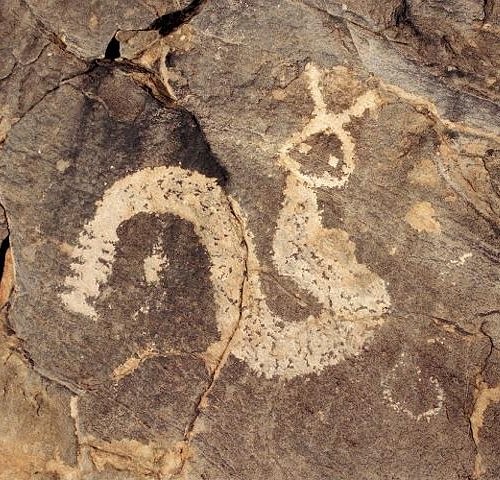
As with all Native American stories, legends, and myths, The Man Who Married the Thunder Sister can be interpreted in various ways. Perhaps the young warrior fell under a spell to test his discernment and failed, or it could be that, until his lapse in not following instructions, he behaved as he should have in rejecting what is offered by elemental spirits he has no business dealing with. The story is as popular today as it was in the past, however, and, as noted, continues to lend itself to many different interpretations.
Text
The following text comes from Myths of the Cherokee (1900) by James Mooney, republished by Dover Publications, 2014, pp. 345-347.
In the old times, the people used to dance often and all night. Once, there was a dance at the old town of Sakwi'yi, on the head of the Chattahoochee, and after it was well-started, two young women with beautiful long hair came in, but no one knew who they were or whence they had come. They danced with one partner and another and, in the morning, slipped away before anyone knew that they were gone; but a young warrior had fallen love with one of the sisters on account of her beautiful hair and, after the manner of the Cherokee, had already asked her, through an old man, if she would marry him and let him live with her.
To this, the young woman had replied that her brother, at home, must first be consulted, and they promised to return for the next dance seven days later with an answer but, in the meantime, if the young man really loved her, he must prove his constancy by a rigid fast until then. The eager lover readily agreed and impatiently counted the days.
In seven nights, there was another dance. The young warrior was on hand early, and later in the evening the two sisters appeared as suddenly as before. They told him their brother was willing and, after the dance, they would conduct the young man to their home, but warned him that, if he told anyone where he went or what he saw, he would surely die.
He danced with them again and, about daylight, the three came away just before the dance closed, so as to avoid being followed, and started off together. The women led the way along a trail through the woods, which the young man had never noticed before, until they came to a small creek where, without hesitating, they stepped into the water. The young man paused in surprise on the bank and thought to himself, 'They are walking in the water; I don't want to do that.' The women knew his thoughts just as though he had spoken and turned and said to him, "This is not water; this is the road to our house." He still hesitated, but they urged him on until he stepped into the water and found it was only soft grass that made a fine level trail.
They went on until the trail came to a large stream which he knew for the Tallulah River. The women plunged boldly in but, again, the warrior hesitated on the bank, thinking to himself, 'That water is very deep and will drown me; I cannot go on.' They knew his thoughts and turned and said, "This is no water, but the main trail that goes past our house, which is now close by." He stepped in and, instead of water, there was tall, waving grass that closed above his head as he followed them.
They went only a short distance and came to a rock cave close under Ugun-yi (Tallulah Falls). The women entered, while the warrior stopped at the mouth; but they said, "This is our house; come in and our brother will soon be home – he is coming now." They heard low thunder in the distance. He went inside and stood up close to the entrance. Then the women took off their long hair and hung it up on a rock and both their heads were as smooth as a pumpkin. The man thought, 'It is not hair at all' and he was more frightened than ever.
The younger woman, the one he was about to marry, then sat down and told him to take a seat beside her. He looked, and it was a large turtle, which raised itself up and stretched out its claws as if angry at being disturbed. The young man said it was a turtle, and refused to sit down, but the woman insisted it was a seat. Then there was a louder roll of thunder and the woman said, "Now our brother is nearly home." While they urged, and he still refused to come nearer or sit down, suddenly there was a great thunderclap just behind him and, turning quickly, he saw a man standing in the doorway of the cave.
"This is my brother," said the woman, and he came in and sat down upon the turtle, which again rose up and stretched out its claws. The young warrior still refused to come in. The brother then said that he was just about to start a council and invited the young man to go with him. The hunter said he was willing to go if only he had a horse; so the young woman was told to bring one.
She went out and soon came back leading a great uktena snake that curled and twisted along the whole length of the cave. Some people say this was a white uktena and that the brother himself rode a red one. The hunter was terribly frightened and said, "That is a snake; I can't ride that." The others insisted that it was no snake, but their riding horse. The brother grew impatient and said to the woman, "He may like it better if you bring him a saddle and some bracelets for his wrists and arms." So they went out again and brought in a saddle and some arm bands and the saddle was another turtle which they fastened on the uktena's back and the bracelets were living, slimy, snakes which they got ready to twist around the hunter's wrists.
He was almost dead with fear and said, "What kind of horrible place is this? I can never stay here to live with snakes and creeping things!" The brother got very angry and called him a coward and then it was as if lightning flashed from his eyes and struck the young man and a terrible crash of thunder stretched him senseless.
When at last he came to himself again, he was standing with his feet in the water and both hands grasping a laurel bush that grew out from the bank and there was no trace of the cave or the Thunder People, but he was alone in the forest. He made his way out and finally reached his own settlement but found then that he had been gone so very long that all the people had thought him dead, although, to him, it seemed only the day after the dance. His friends questioned him closely and, forgetting the warning, he told the story; but in seven days he died; for no one can come back from the underworld, and tell of it, and live.
